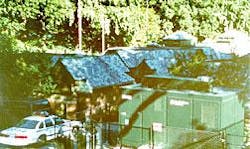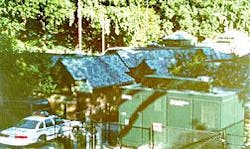Keeping the lights on
Many Americans never contemplated their dependence upon electricity until the lights went out during the blackout that blanketed the US Northeast and Upper Midwest in darkness Aug. 14-15.
The event demonstrated how our dependence upon the electric transmission grid involves subtle details frequently taken for granted: cars require gasoline from pumps powered by electricity, and cell phones depend on towers powered by electricity.
The worst blackout in US history could spur interest in distributed power generation, which is any small-scale power generation technology that provides electricity at a site closer to customers than central-station generation. Fuel cells are examples of technology readily available to bolster the aging, brittle power grid.
For instance, the lights never flickered at a police station in the middle of New York's Central Park. The station's electricity is generated by a fuel cell power plant provided by UTC Fuel Cells, part of the UTC Power unit of United Technologies Corp., Hartford, Conn. UTC Power also sells microturbines.
"The blackout was a wake-up call for many about the need for reliable power. We see distributed generation [DG] as part of the solution for bolstering the grid," said Peter Dalpe, spokes- man for UTC Fuel Cell.
The Central Park police station fuel cell power plant was installed in 1999 because the electric grid feed was insufficient to meet the power needs of the station—a converted stable built in 1870. The New York Power Authority found that the DG alternative was less costly and intrusive than ripping up the park to bury the electrical lines for a new grid feed.
null
Hydrogen future
"Hydrogen is an energy currency that is an alternative to electrons for supporting users with improved reliability performance," said David Haberman, principal of the Los Angeles-based IF LLC, a consulting firm focused on the emerging hydrogen economy.
"Fuel cells were developed in the US for [the National Aeronautics and Space Agency] originally, and the Department of Defense has had many applicationsU. The bottom line is that America has paid for hydrogen and fuel cell technology," he said.
Part of the importance of the hydrogen vision is its promise of energy independence, said Haberman who began his work with hydrogen in the defense industry 15 years ago.
Late last month, he was conference director for a "Cooperation for Energy Independence of Democracies in the 21st Century," meeting in Jerusalem.
The leadership forum focused on how the US, Israel, and their democratic allies can increase cooperative efforts in applying renewable energy toward energy security needs.
"Israel is an excellent venue to do this because it's almost totally dependent upon importing fossil energy. Therefore, the benefit of offsetting any level of that import will be immediate and obvious," Haberman said.
Natural gas
Haberman also advises the Gas Technology Institute (GTI), Chicago, on bridging the natural gas infrastructure to provide for future hydrogen distribution requirements. GTI representatives attended the conference in Jerusalem.
Oil and gas companies have begun to recognize the "inevitability" of renewable fuels, Haberman said. For instance, ChevronTexaco Corp., Royal Dutch/Shell Group, and Norway's Norsk Hydro ASA have invested in hydrogen technology research and development.
"The US currently uses hydrogen in hundreds of ways. We need to adapt our vision to understand that here is yet another, and most certainly best, way to use hydrogen—as an energy carrier. The US is completely equipped for it... We just simply have to hone and expand the system as hydrogen evolves from a chemical to an energy commodity," Haberman said.
The moral of the police station fuel cell power plant story is not the fuel cell itself but rather how DG can bolster the grid so that people need not worry about the reliability of gasoline pumps or cell phones.

